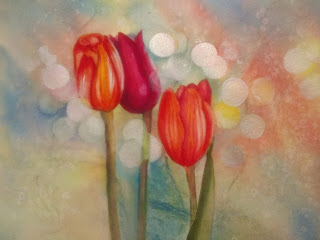Below are some of Steve Mitchell's youtubes on glazing, blending, and creating shadows.
All are really helpful.
Mind of Watercolor: creating shadows on intense colors
https://www.youtube.com/watch?v=_9u61TJ3ems
Mind of Watercolor: fundamentals of glazing
https://www.youtube.com/watch?v=_58Eyyhv0gs&t=10s
How to blend colors wet onto dry
https://www.youtube.com/watch?v=Qy_8px43Esc
MORE THAN ONE WAY TO MIX COLOR
The picture below shows 3 ways to achieve color on your paintng. Top row uses permanent yellow and cerulean in each circle. Bottom row uses alizarin crimson and French Ultramarine blue.On the left is wet-in-wet. Middle shows color mixed on a palette. Circles on the right show glazing.
The left side of top circle has yellow first, cerulean glazed over yellow. The right side has cerulean first, then yellow glazed over that.
TEN REASONS TO GLAZE
On my list, the first 5 are reasons given in the Mind of Watercolor Video. The last 5 other reasons I have used glazing.
1. Control of values (deepening and adjusting values and gradual shading)
2. Subtle color changes
3. "visual mixing" of color
4. Dulling or neutralizing with complementary colors
5. Keeping luminosity
6. Separating planes
7. unifying an object
8. pushing an area into the background
9. underpainting, such as for grisailles
10. Brighten a dull color (either warm up or cool off)
GLAZING EXERCISE
First make some shapes on your paper, any shapes. Make some of them overlap.
Go ahead and put a light to medium coat of flat wash over each shape.
Dry completely.
Now try to use that list of 10 reasons to alter color on each shape.
Top left: #1-- I started with alizarin crimson. I added a deeper shade of red on the front to darken the value of the red. The side of the block shows reason # 10--brightening with quinacridone gold.
On the right I underpainted leaves with yellow. This gave it a bright undertone. I made gradual changes in the greens by adding some greens to the leaves to make gradual changes.
Next row, the overlapping circles show VISUAL MIXING. Think of visual mixing as taking two sheets of colored tissue, a yellow and a red. When you overlap them, your eye sees orange. That is what is happening when you glaze one color over another.
The teal flower petals were painted teal then shaded with pthalo blue. (Shading)
The blue rectangle is #2, subtle color changes.
The orange triangle also demonstrates shading.
the green cross of rectangles shows separating of planes. Think of two green stems, identical in color, but you need to separate the planes (or stems) with a darker color on one so you can see them. I also used a yellow glaze over one of the rectangles to demonstrate #10, warming up a color, which also
helps to separate the planes.
The red ball was painted with Allizarin, then glazed over with green to dull it down.
I have several posts on grisailles, which you can refer for #9.
The most important thing to remember in glazing is that the underpainting must be DRY before you glaze. Steve Mitchell also points out that you don't want to use a mop brush, which holds a lot of water, when glazing. You don't want to disturb the underpainting, and too much water will do that.
SHADING
I used a styrofoam try to make this dot chart of color that follows the color wheel. (mostly...I made a mistake with a red) Looking at your paints in their most intense form will allow you to see just how strong (or weak) a value that paint can go to. Also, it lets you see which colors are closest in the family.
So how does this help you in shading? Steve does a great job of explaining this. When you are shading a color that is already able to achieve a very dark value (French ultramarine for example), or a neutral such as Paynes gray, you can start out light and just use stronger versions of the same color to shade.
BUT
what about your bright intense colors, such as yellow (which gets green if you put in blues and orange if you add reds)? Or reds, which can get muddy if you add a neutral?
For yellow, look on the color chart on the left side and find a yellow (or sienna) that can achieve a value higher than that yellow. I chose quin gold, but other colors can work too. And you can use more than one, building layers.
For reds, instead of going straight to a blue, go to a more intense red or red violet first for your shading.
You can use neutral tint, but tends to make it dull. Especially on flower petals.
So below I made a few shapes that I could shade. Top row shows dark colors that can have a variety of values. Left to right: carbozole, shadow violet, neutral tint, paynes gray, French. Then blue shaded with neutral tint, and red shaded with neutral tint.
Second row: Permanent yellow with quin gold and Burnt orange; Cerulean blue with French; sap green with pthalo blue; alizarin with quin violet. Third row, same yellows, magenta with quin violet, jadite green with itself and pthalo; perm. red with violet. You just have to play to see what works.


























